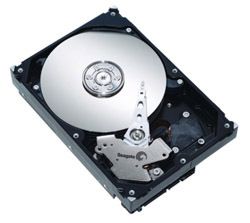Quo Vadis, Hard Drive? The 50th Anniversary of the HDD
Atzkern assumes that we will see hard drives with storage capacities of approximately 4 TB at around 2010.
Tom's Hardware Guide: With half a century of hard disk development behind us, what's Seagate's insight for the next 50 years?
Atzkern: New markets will change the design and use of hard disk drives in the future. Today, hard disks are not only an essential part of desktop computers and server systems, but they are also found in entertainment devices like MP3 players, mobile phones, digital VCRs etc. Therefore, hard disk drives will have to be more efficient, shock resistant and reliable. In addition to that, we need to store an increasing number of digital media like downloaded music files, video on demand and digital photos onto our hard disk drives.
Tom's Hardware Guide: Does this mean smaller platters with higher capacity for the future?
Atzkern: Yes! The trend definitely goes towards smaller hard disk drives; yet with a higher storage capacity. For the next ten years we expect a 40% increase in storage capacity thanks to vertical magnetic recording techniques that are refered to as Perpendicular Magnetic Recording (PMR). Seagate's first two-platter laptop hard disk drive Momentus 5400.3 offers a storage capacity of 130 Gbit/sq-in (gigabits per square inch). A perpendicular demonstration in August 2005 already showed potential up to 240 Gbits/in2. Thanks to perpendicular recording we should be able to double the storage capacity every two years. So, in two years you might be able to get a one-inch hard disk drive with 24 GB and a laptop hard disk drive with 320 GB. Seagate wants to double the storage capacity every two years and aims at a 500 Gbits/in2 through perpendicular recording in four to six years.
Using different technologies is absolutely unnecessary at this point. Not only would a change mean higher costs, but we would also need a new production infrastructure. In the future, we will likely introduce technologies like HAMR, Bit Patterned Media or SOMA to increase storage capacity. We want to offer 1.3 Terabyte platters with a storage density of 1000 Gbits/sq-in through the 2012.

Tom's Hardware Guide: So magnetic storage will be the main storage medium! Do you think canmight last another 10, 20 years... or even longer?
Atzkern: Magnetic storage devices will absolutely be the most important storage type. At the moment we believe that perpendicular recording will not exceed a storage density of 500 Gbits/sq.in. An estimated 40% growth in storage density would reach its peak in 2010.
Stay on the Cutting Edge
Join the experts who read Tom's Hardware for the inside track on enthusiast PC tech news — and have for over 25 years. We'll send breaking news and in-depth reviews of CPUs, GPUs, AI, maker hardware and more straight to your inbox.
Right now, Seagate is developing a new technology called Heat Assisted Magnetic Recording, which can be compared to what you would refer to as magneto-optical recording (MO). A laser heats up the area that is to be written on until it reaches the Curie temperature point. This procedure makes is a lot easier to store data onto the heated area. It also provides better resistance against the superparamagnetic effect, a phenomenon that causes bits to suddenly and spontaneously loose their magnetic alignment as well as their polarity.
Current page: Atzkern assumes that we will see hard drives with storage capacities of approximately 4 TB at around 2010.
Prev Page Seagate's Opinion on the Future of Magnetic Mass Storage Next Page Quo Vadis, Hard Drive? The 50th Anniversary of the HDDMost Popular

